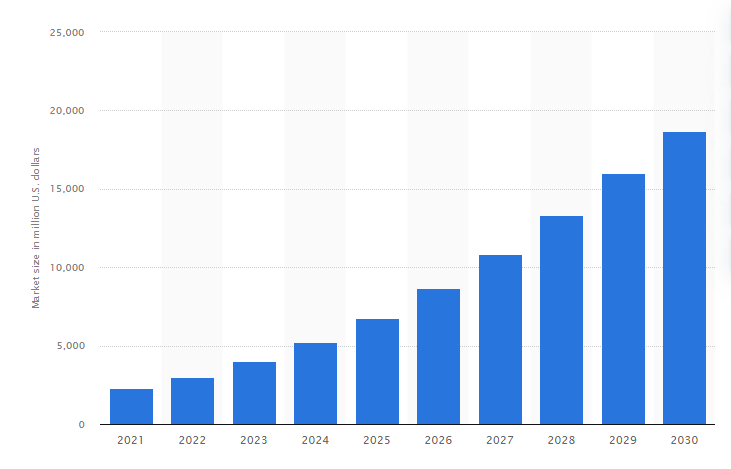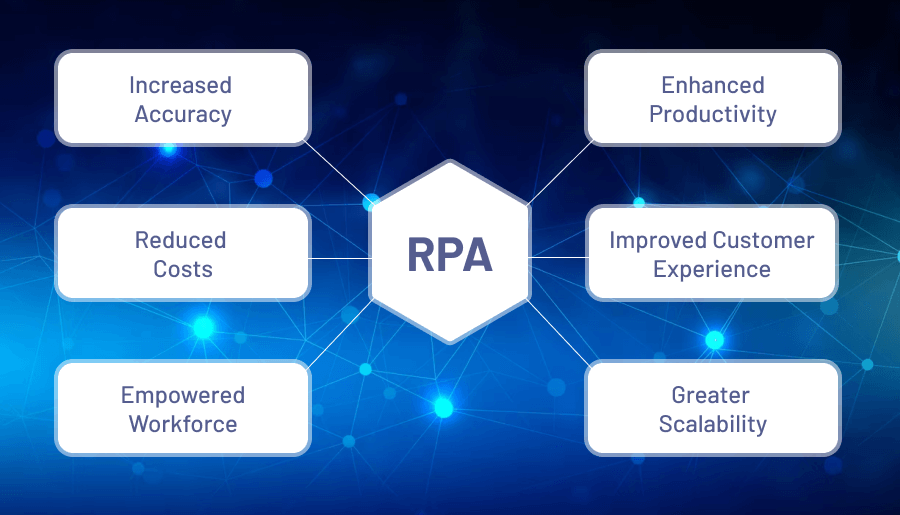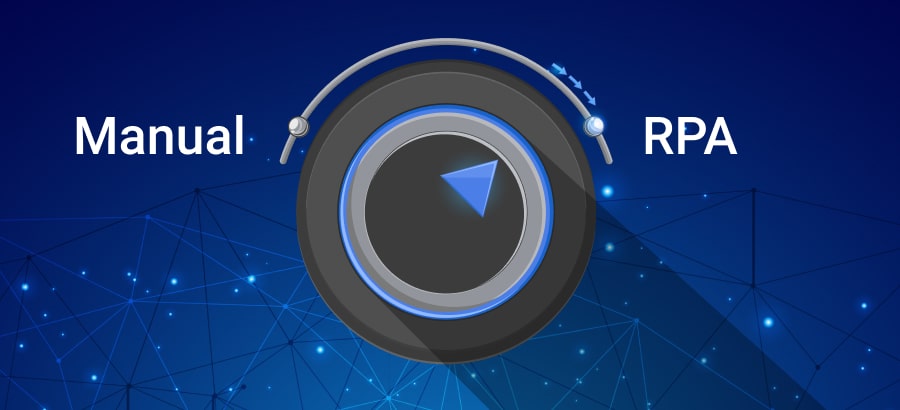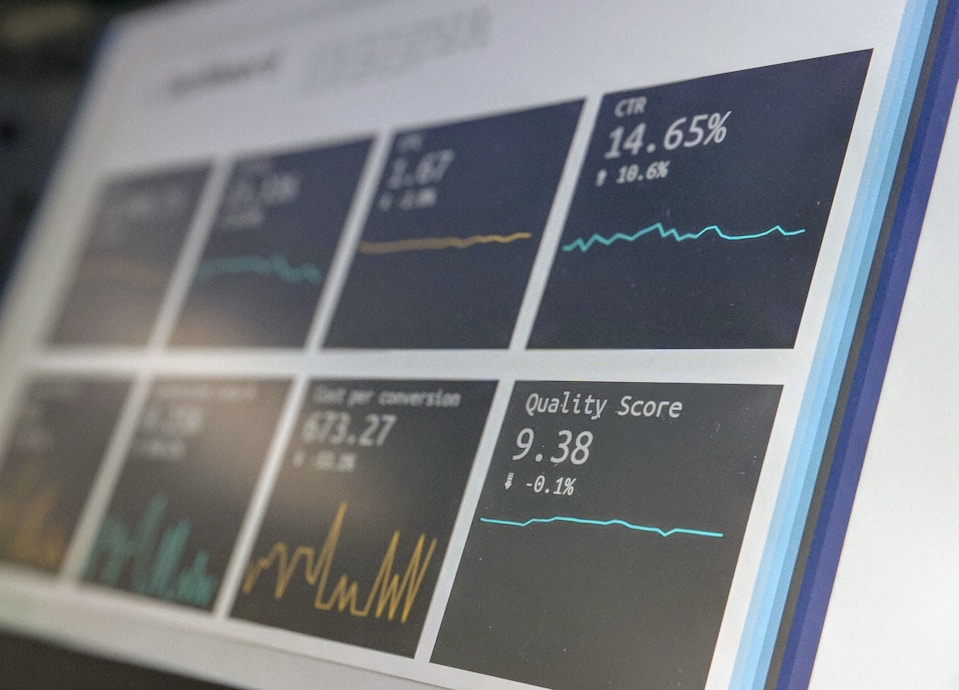Robotic Process Automation, or simply RPA, is one of the powerful solutions that many businesses apply today in their daily operations. If you are one of those who consider the automation of business processes as an efficient way to address the company’s goals, then this blog post is a primer for you to pore over.
The Rise of RPA
Some CEOs and CIOs use robotic process automation in business to streamline company operations and reduce costs; others find it a transitional option en route to AI and Machine Learning adoption. Whatever the reason, the stats tell us the popularity of RPA is not fiction.
Statista estimated the size of a global RPA market to reach almost $19 billion by 2030, growing nearly fivefold since 2023. It means that many organizations will continue to show interest in digital transformation and dabble in some form of RPA to leverage their business.

Let’s take a good look at what RPA really is, its best practices, and how it can help you address challenges and transform them into competitive advantages.
What Is Robotic Process Automation and How It Works
First of all, robotic process automation is an application of technology designed with one principal purpose — to automate repetitive tasks based on logic and perform them without human intervention. In other words, RPA is a software that helps eliminate manual efforts and carries out a ton of actions, swiftly and flawlessly.
With the implementation of RPA, companies can set up tools to process transactions, manage data, trigger responses, and interact with other enterprise systems. This is achieved by programming a software robot to imitate user actions, i.e., by defining a set of rules to perform the workflow.
The video below explains briefly the basic principles of how RPA works. Take a moment to watch it.
The scenarios of RPA use include filling out various forms, logging in and out of apps, copying and pasting data, or even generating responses to emails.
You might think it takes a touch of genius to adjust such an instrument. Well, when it comes to complex and non-trivial tasks, it is better to have the support of a team experienced in business process automation. At the same time, many RPA vendors provide low-code or no-code software with drag-and-drop components or pre-built UI that you can use to design a simple bot.
Learn more on How Low-Code Helps Companies Automate Business Processes
What Is the Difference between RPA and Traditional Automation?
You now may wonder how then robotic process automation differs from the traditional one. Well, while both types aim to streamline processes, they don’t use the same ways to achieve it.
The nature of traditional automation is built around scripts or coding to automate specific processes. It can range from simple script-based automation to more complex solutions involving tools like Business Process Management or workflow automation.
On the other side, RPA is about using software robots or RPA bots to mimic human interactions with software applications and systems. As we’ve mentioned, it operates at the user interface level and is capable of handling rule-based, repetitive tasks.
Other distinctions lie in their abilities to scale and integrate with legacy systems, as well as the time and effort required to implement them. RPA has proved to be more scalable unless it involves complex or non-standard processes. On top of that, it usually depends less on specialized technical skills and can work with existing software infrastructure without extensive modifications.
However, traditional automation may offer more sophisticated solutions at the cost of potentially higher complexity and longer development timelines. So, it’s obvious that the choice between these two types will be based on your specific requirements and the characteristics of the processes you want to automate.
The Benefits of Robotic Process Automation
RPA can provide companies with an extra set of hands to drive digital transformation for better growth or become a part of their digital strategy during downturn times. It comprises more than a few advantages, drawing the interest of organizations across all industries.
So, let’s go over the benefits these user-friendly and cost-effective RPA tools deliver to businesses that adopt them.

Increased Accuracy
We make mistakes because we are humans, not robots. This implies that error-free operations are exactly what we expect to see when we implement RPA. And that’s exactly what we get.
RPA is made to follow all rules to the letter, which increases accuracy to the maximum and ensures higher quality. Where a human needs to rest and can lose focus, a robot keeps functioning in a troubleproof and reliable way.
Enhanced Productivity
RPA capabilities enable the execution of a large number of operations much faster than any employee can do. It means that RPA maximizes effectiveness and reduces time to process mundane activities. As a result, it helps companies deliver their service at a greater speed and increase the efficiency of internal business processes.
Reduced Costs
Passing repetitive and time-consuming tasks to robots naturally leads to the reduction of operating costs. Since RPA software functions 24/7, any chore performed by this tool significantly cuts business expenses.
Moreover, RPA is, generally, a less costly method of enhancing existing IT infrastructure. That makes it a cost-effective automation tool.
Explore how efficient IT infrastructure services can optimize your RPA implementation.
Improved Customer Experience
The quality of the provided services and the speed of their delivery play an essential role in customer satisfaction. In most cases, RPA tools handle data more efficiently and accurately. Thus, with the automation of processing simple requests, customer experience improves considerably, leading to an increase in loyalty.
Empowered Workforce
The implementation of RPA can save hours of avoidable work as it allows back-office specialists to have more time and concentrate their efforts on more meaningful and value-added tasks.
Eventually, RPA adoption reduces the rising pressure of work for employees, eliminating the number of manual activities. It fosters the effective use of staff resources, increases employee satisfaction, and eventually improves company results.
Greater Scalability
The last benefit of robotic process automation we’ll talk about today is the scalability and flexibility it offers to companies. Here, we mean that the technology allows businesses to easily scale their operations without proportional increases in labor costs. This is because again RPA bots can handle a growing volume of tasks while you don’t have to involve any additional resources.
At the same time, such flexibility extends beyond mere volume handling and encompasses rapid deployment and continuous operation. All that makes RPA a versatile solution for businesses facing varying workloads and operational demands.
Challenges of RPA Implementation

This article would be incomplete, of course, without mentioning the top considerations of enterprise process automation with robotic technology. While there can be more than the four outlined below, we’ve decided to focus on the most principal ones in our opinion.
Process Identification
The key to the success of any technology initiative is careful planning. It’s no different with RPA either. The first crucial step is to identify and select suitable processes that you need to automate. And here lies the challenge, especially when dealing with complex, variable, or non-standardized tasks.
Here, it’s important to consider a variety of things like interdependencies, resource intensiveness, technological compatibility, change management, and cost implications. Moreover, not all the tasks can be automated. We’ll discuss the examples in the following chapter.
Resistance to Change
The same as with generative AI solutions that recently captured all attention in the business world, RPA integration into workflows makes employees fear job displacement. Sometimes, this resistance is also linked to a lack of understanding of how the technology works and what its purpose is.
To address these concerns, change management and clear communication are crucial. Promote the culture of learning to facilitate RPA adoption and explain the shifts in job roles if they arise. People should know that this is not to replace them but to actually help.
Limited Cognitive Abilities
This is about false expectations. While planning what operations to automate, keep in mind that RPA isn’t designed for tasks requiring high-level cognitive abilities, creativity, or complex decision-making. Leave it to GenAI. RPA can excel in repetitive and rule-based tasks but may struggle with what involves nuanced judgment.
GenAI for Business
Watch our webinar to uncover how to integrate GenAI for improved productivity and decisions.
Dependency on Stable Processes
Stable and standardized processes are the best to apply RPA for their automation. It’s best when the task follows certain patterns, steps, and rules and doesn’t undergo frequent changes. This allows for a more straightforward mapping of automating workflows.
If processes are subject to significant variations, you may face challenges. Particularly, in maintaining the alignment between RPA configurations and evolving workflows that potentially require frequent adjustments and increased maintenance efforts. This poses a greater risk of operational disruptions.
The Adoption of RPA: Examples of Robotic Process Automation
When you consider some process automation, you have to ask yourself how to address your company’s needs and achieve your business goals in the most efficient way. It is important to understand how exactly you can benefit from robotic process automation software.
Before adopting RPA technology, make sure the processes that you are about to automate:
- Have a high volume
- Are routine and consistent
- Have defined inputs and outputs
- Entail human error possibility
- Impact costs and revenue
Going through examples of use cases and application areas of RPA can help you discover new opportunities for growth.

Robotic process automation can become a great partner when there is a need to handle activities with a high level of human data processing. You can easily find such tasks across many service departments like Finance & Accounting, Human Resources, Customer Service, Procurement, etc.
Read How Chatbots Help Improve Customer Service
For example, if your staff is processing millions of records relying solely on the manual approach, this is a perfect task to augment with a robotic solution. As a result, you will see improvements in operational scalability while there will be no need to hire more staff.
One of the cases in our practice was the automation of data processing for the top executive search firm. The implemented RPA solution enabled the company to keep its database up-to-date and save time on the daily routine.
“The most common uses of RPA programs supplement repetitive functions or data-intensive processes, where logic-based outcomes are anticipated.”
— David Landreman, the CPO at Olive
RPA generates value for organizations across many industries. Finance and Banking, Insurance, Retail, Supply Chain, and Healthcare embrace the benefits of RPA to tackle their challenges. Among the top business processes where RPA drives value are:
- Invoice processing
- Report creation
- Running payroll
- Inventory management
- Data migration
- Recruitment and onboarding
- Underwriting
- Bank reconciliations
- Appointment scheduling
- Insurance claims management
Digital Transformation with RPA
RPA has enormous potential to help companies solve their operational challenges and transform offices into digital workplaces. Combined with Business Process Management tools, RPA can fill in the gaps where it is most needed while reducing costs and increasing productivity.
RPA applications don’t always require a lot of coding or complex integrations. In this matter, it can be set up without much effort. However, it’s worth mentioning that often, you will need an experienced team to work on it. The majority of companies prefer to have a software development partner to provide skills and advice that are scarce in their own company.
At Velvetech, we guide our clients to success with effective software solutions to accelerate their business. Regardless of your industry, our experienced team will help you navigate the waters of process automation and support you with the right RPA tool implementation. Don’t hesitate to contact us for a consultation.































